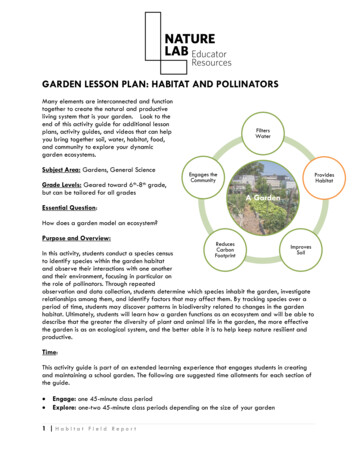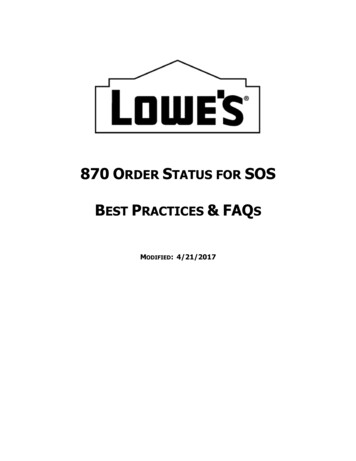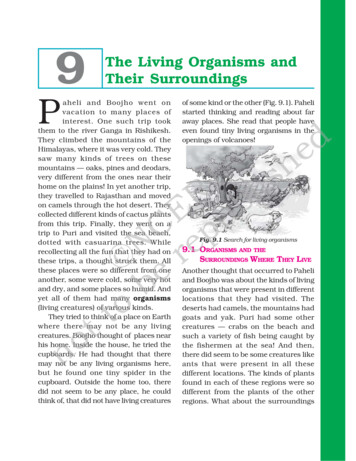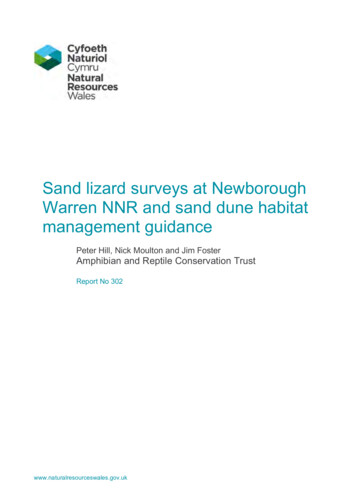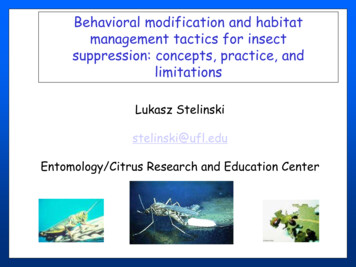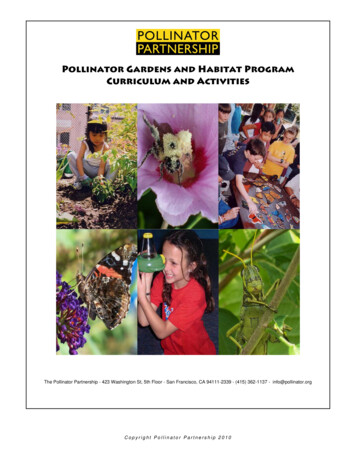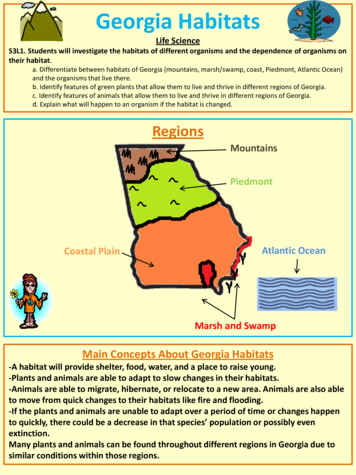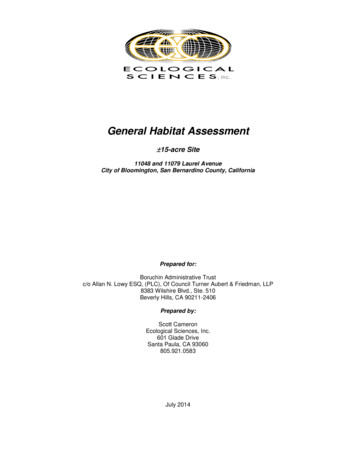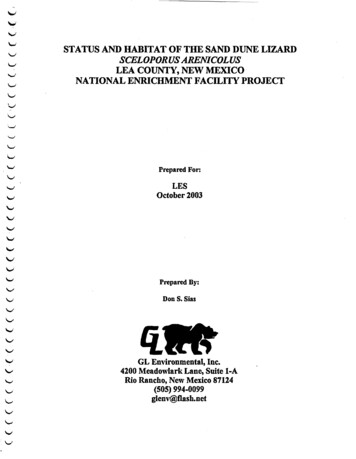
Transcription
STATUS AND HABITAT OF THE SAND DUNE LIZARDSCELOPORUS ARENICOL USLEA COUNTY, NEW MEXICONATIONAL ENRICHMENT FACILITY PROJECTPrepared For.LESOctober 2003Prepared By:Don S. SiasGL Environmental, Inc.4200 Meadowlark Lane, Suite 1-ARio Rancho, New Mexico 87124(505) 994-0099glenv flash.net
Sand Dune Lizard StudyNational Enrichment FacilitySUMMARYSand dune lizard (Sceloporus arenicolus) surveys were conducted at the proposed LESNEF site in Lea Co., NM, Section 32, T21S, R38E. This site is four miles east ofEuncie, north of NM Hwy 234. Sceloporus arenicolus (Sa) is listed as a threatenedspecies by the New Mexico Department of Game and Fish and is listed as a candidatespecies by the United States Fish and Wildlife Service. Field surveys during 26-29 Sep.2003 resulted in no sand dune lizards detected and a determination of unsuitable habitaton Section 32 and the surrounding areas. Previous studies (Fitzgerald et al. 1997, Siasand Snell 1998) did not search the Section 32 study site, but did map some of thegeographic range and habitat of the sand dune lizard 5.75 miles north of Section 32.Sand dune lizards were active in these areas on the same days Section 32 was searchedwith negative results for sand dune lizards.This survey, and other recent surveys (vegetation) found some habitat components (sanddunes, shinoak, blowouts) that are associated with sand dune lizards. But the dunes,blowouts and shinoak occurred in configurations and locations that did not support sanddune lizards on Section 32. The shinoak habitat of Section 32 was ecotonal withmesquite and grassland associations. In contrast, the habitat of sand dune lizards isshinoak dominant, sand dunes. The vegetation on Section 32 probably reflects differentsubstrate conditions (finer particle size) that will not support sand dune lizards.The predominant microhabitat of sand dune lizards is sandy blowouts (open depressionsin substrate). But section 32 had a significantly lower proportion of large blowouts thanoccupied sand dune lizard habitat. Section 32 shinoak dunes were low, small in extent,patchy in location and isolated from suitable habitat to the north. Only two habitatdescriptions (2/76) were dunes dominated by shinoak. All other habitat descriptions(74/76) described other habitat types or shinnery dunes vegetated with mesquite scruband grassland flora.Surveys north of Section 32 showed that the area between occupied habitat and the studysite consisted of roughly one mile of dispersal habitat (shinoak flats) trending south ofoccupied areas. These shinoak flats merged into ecotonal mesquite scrubland andmesquite grassland associations. These are habitats where sand dune lizards have notbeen detected and were classified as unsuitable.
National Enridunent FacilitySand Dune Lizard StudyTABLE OF CONTENTSSummaryIntroductionIMaterials and Methods1Results5A. The occurrence of sand dune lizards on section 32, T21S, R38E.5B. The geographic range of sand dune lizards in the vicinity ofsection 32, T21S, R38E.C. The habitat and habitat classification of section 32, T21S, R38E inreference to the sand dune lizard.DiscussionLiterature cited68911FiguresFigure 1. Suitable and unsuitable habitat (in Results).Figure 2. A map of the geographic range of sand dune lizards (Sceloporus arenicolus)insoutheast NM.Figure 3. A map of the area between the study site (sec. 32) and the nearest sand dunelizard (S. arenicolus) (Sa) localities.TablesTable 1. Reptile abbreviations used in this report, Table 2 and Appendix I (in Materialsand methods).Table 2. Summary of lizard surveys (a portion is located in Results).Table 3. Notes on habitat between sand dune lizard occupied localities and section 32.Table 4. A summary of plant habitats from point descriptions taken during lizard surveyson section 32.Table 5. A comparison of blowout size distribution and local topographic relief betweensection 32 and two other sand dune lizard habitat studies in southeast NM.AppendicesAppendix 1.Appendix 2.Appendix 3.Appendix 4.Field data for lizard and habitat surveys on section 32.Reference GPS points for lizard/habitat surveys and the section 32 area.Plant and vegetation community abbreviations: Appendix. I and Table 4Photo references of habitats and species.
Sand Dune Lizard S&adyNational Enrichment FacilityINTRODUCTIONThis report presents the results of sand dune lizard (Sceloporus arenicolus) surveys insoutheastern New Mexico, Lea County at a specific site: Township 21S, Range 38E,section 32 north of NM hwy 234, an area of 543 acres four miles east of the town ofEunice. This report also includes results of surveys in the vicinity of this site todetermine the status and habitat of the sand dune lizard in this area and at this study site.Section 32 is NM state land and the proposed location for an LES National EnrichmentFacility. This study was commissioned by GL Environmental Inc. for LES (LouisianaEnergy Services).Sceloporus arencolus (Sa) is listed as a threatened species by the New MexicoDepartment of Game and Fish and is listed as a candidate species by the United StatesFish and Wildlife Service. The primary threat to date has been habitat destruction in thelimited regions of southeast New Mexico and west Texas where the species occurs. S.arenicolus occupies habitats primarily comprised of shinnery oak (Quercus havardii)sand dunes (Appendix 4, photo 1). In addition to habitat specialization, this species is amicro-habitat specialist, almost all sightings occur in blowouts (open sand bowl-likedepressions) that develop in shinnery oak sand dune localities (Appendix 4, photo 2).Furthermore, S. arenicolus exhibits a distinct preference to occupy large blowouts(Fitzgerald et al. 1997, Sias and Snell 1998, Sias 2002). Localities near the known rangeof S. arenicolusthat contain shinnery oak, sand dunes and blowouts merit investigation.Field surveys were based on protocols used in previous studies of S. arenicolus(Fitzgerald et al. 1997, Sias and Snell 1996, Sias and Snell 1998, Sias 2002, Sias 2003).As a consequence, survey data in this report is directly comparable to past and futuresand dune lizard surveys. We used the data to address three project issues: 1) determinethe presence or absence of S. arenicoluson section 32; 2) determine the habitat suitabilityof section 32 for S. arenicolus; 3) determine the biogeographic relation between sec. 32and the nearest suitable habitat (occupied and or potential classifications).MATERIALS AND METHODSInformation from this report came from the following sources. Field work was conductedfrom 25-29 Sep. 2003. Previous work in the area reported in Fitzgerald et al. (1997), Siasand Snell (1996), Sias and Snell (1998), Sias (2002) provided localities of sand dunelizards and habitat information. During the 25-29 Sep 2003 field surveys, no S.arenicolus were disturbed or collected. Standardized lizard surveys include timedwalking in predetermined areasldirections with close focusing binoculars and recordingall reptiles seen and various habitat components related to S. arenicolus. The methodsused in these surveys are reported in detail in Fitzgerald et al. (1997) and Sias and SnellLES NEF sand dune lizard report Page 1
Sand Dime Lizard StudyNational Enrichment Facility(1998). Before and after standardized lizard surveys, sites of known sand dune lizardoccurrence were visited to determine lizard activity (verification survey in Table 2). Thisprovided a higher degree of confidence (i.e. information about the presence / absence andabundance of the lizard) for surveys where sand dune lizards were not found. The 25-29Sep. field surveys covered the entire 550 acres, regardless of habitat type. Noassumptions were made about S. arenicolus habitat utilization. If S. arenicolus wereseen, these localities were recorded with GPS receivers and additional habitat informationwas collected to ascertain habitat and microhabitat utilization. This information isrelevant to developing localized mitigation measures.Four standard lizard surveys and a general area and boundary inspection were conductedon sec. 32. The standard lizard surveys started on the north boundary and the observerwalked zigzag se-sw in a 1/4 mile band south until the Highway 234 fence wasintersected. The observer then walked to the adjacent band, reversed direction andwalked back to the north boundary.The closest site of known S. arenicolus occurrence (T20S, R38E, sec 36) was visitedbefore and after each sand dune lizard survey of the study site (sec. 32). The northwestcorner of sec. 32 was 5.75 miles south (176 ) of the verification site. The author of thisstudy was aware of seasonal aspects of New Mexico lizard fauna activity. Before section32 was even visited, the sand dune lizard verification locality was visited to evaluate thefeasibility of S. arenicolus surveys. Six S. arenicoluswere observed for one hour (12:0013:00) to see what behaviors the lizards exhibited, what type of movements occurred andwhat microhabitats were utilized (Appendix 4, photos 3, 4, 5). S. arenicolusactivity anddaily temperatures determined the times of lizard surveys.The environmental information collected during timed surveys described the habitat andmicrohabitat and was used in determining habitat suitability for S. arenicolus. This studycollected the same information and used the same methods in Sias and Snell (1998), Sias(2002), Sias (2003). In brief, these surveys include collecting the following data. Thenumber of blowouts walked through (Appendix 4, photos 2, 14-17). The size of theseblowouts was recorded as BS, BM, BH (blowout maximum linear or curvilinear length,blowout small (BS) 25 ft, blowout medium (BM) 25-80 ft and blowout huge (BH) 80ft). At S. arenicolus localities additional information collected would include theblowout depth (if the site was a blowout) or a description of the mico-habitat and habitat.At 15 minute intervals an estimation of open substrate (%/o, based on ten points 25 maround the observer), local topographic relief (R), (5 points at 25 m around the observerand vegetation/habitat types was made (four quadrants (Q14) at 0-50 m based on N, E,S, W directions).The vegetation-topography types (Table 4, Appendices 1, 3) are described in order ofdominance using abbreviations (Appendix 3). For instance in Table 4 "mgy" indicates amesquite grassland with scattered yucca, sd-(low)mgy indicates low shinnery dunes arepredominant with mesquite, grass, and yucca present in order of their relative frequency.Air temperature (two inches above substrate) and substrate temperature was recorded atthe beginning, middle and end of surveys.LES NEF sand dune lizard veport Page 2
National Enrichment FacilitySand Dune Lizad StudyThe data collected during timed lizard surveys is presented in Appendix one. ReferenceGPS points for section 32 and the lizard/habitat surveys are shown in Appendix 2. Plantand vegetation community abbreviations are shown in Appendix 3. These are used inAppendix 1 and Table 4. Also Appendix 3 contains comments about plant associationsthat are suitable, unsuitable and dispersal habitat for S arenicolus. Appendix 4 containsreference photographs of the habitat and sand dune lizards.Several habitat terms were used in this report that require definition. Figure 1 (following)discusses the idea of habitat suitability used in this report.Figure 1. Suitable and unsuitable habitat,44i4-High populations. Habitat that supportstgrowt.maintenance and reproduction.0.8\ b -Moderatepopulations. Habitat that supportsgrowth. maintenance and reproduction.dLow populations. Habitat that supportsgrowth. maintenance and reproductionsubject to high levds of environmentalconstraints.I- Sporadic presence - Dispersal habitat-depends on habitat type and locationnUnsu itablehabitatHabitat Dimension (ic. presence o f shinneiy oak, sand particle size,food, the size of blowouts, etc.).Suitable habitat is habitat that will support growth, maintenance and reproduction of sanddune lizards in high, moderate and low populations. It can be occupied or unoccupied bysand dune lizards. Dispersal habitat is habitat that generally occurs adjacent to shinneryoak sand dunes and blowout complexes, that sand dune lizards may move through atvarious times. Habitat is classified as dispersal if our knowledge of sand dune lizardssuggests that sand dune lizards can move and disperse through this habitat with areasonable level of survivability. Unsuitable habitat is habitat that does not supportgrowth, maintenance, reproduction or dispersal of sand dune lizards.LES NEF sand dun lizard report Page 3
National Enrichment FacilitySand Dune Lizard StudyTable 1, below shows the reptile abbreviations, common and scientific names used in thisreport and in Table 2, the summary of lizard surveys.Table 1. Reptile abbreviations, co mon and scientific names used in this report.Reptile abbreviations used in report Scientific nameCommon nameand tablesSaSceloporus arenicolusSand dune lizardyoung of yearyoyUsUta stansburanaSide-blotched lizardCtCnemidophorus tigrisWestern whiptail lizardCtTCnemidophorus tigris (tracks)Western whiptail lizard tracksHmHolbrookia maculataLesser earless lizardSuSceloporus undulatusPraire (fence) lizardCsCnemidophorus sexlineatusSix-lined racerunnerPCPhrynosoma comutumTexas homed lizardToTerrapene omataOrnate box turtleToTTerrapene omata (tracks)Ornate box turtle tracksSnake tracksSnake TCr.viCrotalus viridusWestern rattlesnakeMf.flMasticophis flagellumWestern coachwhip snakeXx-mmaleXx-ffemaleXxjuvjuvenileLES NEF sand dune lizard report. Page 4
National Enrichnent FacilitySand Dune Lizard StudyRESULTSThe Occurrence of Sand Dune Lizards on Section 32, T2IS, R38E.Table 2 summarizes the reptiles found during lizard surveys. A portion of this table isshown below.Table 2 portion. Summary of lizard surveySurvey TypeSurveyTotal AproxSa Us Ct CtT Hm Su No ID Cr.vi Ma.fil Snake ToTdatetime distanceLizTrack(hrs) walked(mi)Sa verificationGeneral siteand 00Road surveyHwy NM 234/TX 17626-Sep-03Sa verificationSec. 32 westside27-Sep-0327-Sep-030.172.000.104.00Sec. 32 westcentralSec. 32 westcentral27-Sep-032.00Sa verificationSec. 32 eastsideSec. 32 eastcentral27-Sep-0328-Sep-035 20 170100002 00 540000014.000 130000.252.750.055.503 60 36020028-Sep-032.004.000 21 2Sa verification28-Sep-03Sa in vicinity,29-Sep-03checked N ofsec. 32. See T2,T3, Sa onlyrecorded0.571.750.306603.00 0100001000 -Sep-030.Table 2 includes surveys at the study site, verification site and a locality between thestudy site and the nearest S. arenicolus occupied locality, which in the case of this studywas the verification site. During lizard and habitat surveys between the dates 26-29 Sep.2003 no S. arenicoluswere found on section 32 or in areas immediately adjacent to thissite. A total of 12.25 man-hours of lizard/habitat surveys at sec. 32 yielded no S.arenicolus. Additionally a total of 8.75 man-hours of standardized lizard surveys yieldedLES NEF sand dune lizard eport Page 5
Sand Dune Lizard StudyNational Enrichment Facilityno S. arenicolus. In contrast, at the verification site 1.49 man-hours yielded 16 S.arenicolus. A supplemental way of viewing this data was to compare distances walkedwith the numbers of S. arenicolusseen. A conservative estimation (walk speed two milesper hour, or 33% of time was spent writing notes or using binoculars) showed that 21.50miles of walking in section 32 yielded no S. arenicoluscompared to the verification sitewhere 0.65 miles of walking resulted in 16 S. arenicolusobserved.Note that habitat inspection and formal lizard surveys were conducted on 26-28 Sep. atthe site. During each day, before and after these surveys S. arenicoluswere active at theverification site 5.75 miles to the north. Not included in the distance or time calculationswas additional work at sec. 32. For instance on 29 Sep. the author went to the study siteall morning to photograph habitat and re-inspect areas of shinnery oak sand dunes /blowouts. No S. arenicoluswere observed during these walks.The Geographic Range of Sand Dune Lizards In The Vicinity of Section32, T21S, R38E.Figure 2 is a map of the geographic range of S. arenicolus in southeastern NM. This mapshows all historical range records and all locality records of S. arenicolus (present orabsent) from more recent studies (Fitzgerald et al.1997, Sias and Snell 1996, Sias andSnell 1998, Snell et al. 1997). Note that there are no documented records in NM of S.arenicoluswest or south of the study site (open circles, Fig. 2).The range of S. arenicolus in NM passes across localities located roughly six miles northof the study site. This shinnery dune field extends into east into Texas and containsoccupied habitat (Painter and Sias 1998). Because of land ownership patterns, the rangeof S. arenicolus is incompletely known in Texas. On 26 Sep. the author drove 16.7 mieast of the entrance to sec. 32 on NM Hwy 234/TX Hwy 176 and inspected the habitatnorth and south of the highway. There was no adjacent shinnery dune habitat. Clearedmesquite (Prosopis glandulosa) fields, mesquite scrub, agricultural areas, mesquiteshinoak scrub and mesquite shinoak grassland comprised the visible habitats. Thesehabitats are unsuitable for S. arenicolus.In Texas, on Hwy 234, 3.4 mi east of the section 32 Rd entrance, one can see on the northhorizon the shinnery dune complexes that form the eastward extension of the verificationsite. These observations confirmed that there was no suitable habitat for S. arenicoluseast of section 32 adjacent to NM Hwy 176/TX Hwy 234.Figure 3 is a map that shows the immediate area between the study site and the nearestoccupied S. arenicolus localities. This interlying area was checked for suitable habitatfor S. arenicolus by driving on roads in this area and in some cases by lizard surveys(Table 2). Table 3 shows the notes on habitat observations made between the Sarenicolus verification site and section 32. A series of GPS waypoints were taken tomark these observations and are plotted on Figure 3 as open circles. No S. arenicoluswere seen at any of these spots.LES NEF sand dunc lizard meport Page 6
Sand Dune Lizard StudyNational Enrichment FacilityThe waypoint EUN VERIF (Fig. 3, large black circle) marks the verification survey siteand a line of shinnery oak dunelblowout complexes that extend east into Texas. Thisdune field supports high population densities of S. arenicolus(Fitzgerald et al, 1997, Siasand Snell 1998). South of this field are extensive shinnery oak flats with widely scatteredblowout complexes that are small in extent ( 100 in), and low in height. No S.arenicolus have been reported from this area (Fig. 2-3, Fitzgerald et al. 1997). It islikely that S. arenicolus, during periods of high population abundance, may dispersethrough these shinnery oak flats and may survive for short periods in these small isolatedblowout complexes (Sias 2002) that are near EUN VERIFI.However, inspection of the area south of EUN VERIFI in 1994 (my field notes from thestudy Fitzgerald et al. 1997) and in 1996-7 (my field notes from the study Sias and Snell1998) revealed few large blowouts to serve as appropriate microhabitat and no S.arenicolus or suitable survey sites were found. For some distance south of EUN VEFIFIthe habitat may be classified as suitable marginal and dispersal. Based on observationsfrom EUN NORTHI and EUN WINDM2 (table 3) this marginal and dispersal habitatmay extend 1 miles south of EUN VERIFI. This places section 32 at 4.75 miles southof marginal and dispersal habitat and 5.75 miles south of occupied habitat.Table 3 notes show that at the next waypoint south, EUN NORTHI, 2.5 mi (south) at 220from EUN VERIFI the shinnery oak habitat is fragmented and ecotonal. Some shinneryoak dune patches occur 100-200 m east and continue east of this waypoint. Theseisolated dune complexes end approximately 200 m south of the waypoint. Lookingnorth, between EUN NORTHI and the verification site are extensive shinnery oak flatsinterspersed with mesquite associations. Mesquite associations are evident in alldirections. The waypoint EUN NORTHI is 3.7 miles at 1590 from the northwest cornerof section 32. The frequency of mesquite was indicative unsuitable conditions for S.arenicolus.West of all waypoints between EUN VERIFI and EUN NW SEC (32) (from north tosouth: EUN NORTHI, EUNWINDM2, EUN NORTH6, EUN NORTH5, EUNNORTH7) are mesquite scrublands and grasslands with a shinoak component. Thefrequency of mesquite and absence of dune formations make these areas unsuitablehabitat for S. arenicolus.At the locations EUN WINDM2, EUN NORTH5-7 and east of these locations areecotonal shinnery-mesquite associations and non shinnery habitats. Small patches ofshinnery oak flats and dunes are scattered throughout this area, but they are isolated fromthe extensive shinnery dominant habitats to the north. The small size, isolation andecotonal aspect of these shinnery habitats suggest these areas north of section 32 areunsuitable habitat for S. arenicolus. Table 2 shows that a S. arenicolus survey wasconducted in portions of sections 30,19, T21S, R3SE for 1.75 hours. This was an isolatedpatch of shinnery dunes (low/med), but it was searched since it appeared to contain theenvironmental characteristics associated with S. arenicolus occurrance. No S. arenicoluswere found. This survey site (EUN NORTH5) was 4.8 mi at 180 from the nearestoccupied habitat (EUN VERIFI). In a line north, intervening between these points was atLES NEF sand dune lizard rpot Page 7
National Enrichment FacilitySanld Dune Lizard Sttidyleast 3 mi of unsuitable habitat (mesquite associations) before dispersal class habitatwould reached. Because of the small size and isolation of this dune field it is highlyunlikely S. arenicolus would be able to colonize and persist in this area. Also thepresence of mesquite surrounding this area suggests that the substrate particle size of thisshinnery dune complex may be inappropriate (too fine) for S. arenicolus(Fitzgerald et al.1997).The Habitat and Habitat Classification of Section 32, T21S, R38E inReference to the Sand dune Lizard.Table 4 shows a summary of the plant habitat descriptions taken as point quadrantsamples (Appendix 1) during lizard surveys on section 32. The surveys resulted in 76different plant habitat descriptions out of a possible 136 different descriptions (Appendix4, photos 6-17). High numbers of different habitat descriptions are characteristic ofecotonal areas and portray unsuitable habitat for S. arenicolus. Using this system ofcharacterization in Table 4, S. arenicolus habitat would be described only by the terms(sd shinnery dunes, sf shinnery flats) sd-(high), sd-(med), sd-(low) and sf, with g(grass), ss (sand sage Artemesiafilifolia), y (yucca Yucca glauca) present. There are norecords of S. arenicolustaken from other habitats (Fitzgerald et al. 1997, Sias and Snell1996, Sias and Snell 1998, Sias 2002, Sias 2003). Shinnery oak dune patches were onlypresent in 2 of 76 samples and these were low dunes (sd-(low)). Low shinoak sand dunesare associated with low and marginal populations of S. arenicolus (Sias and Snell 1998,Sias 2002, Sias 2003). Shinnery oak dunes with mesquite present occurred in 25 of 76samples (Appendix 4, photos 10, 13-17). Shinnery oak was present 63 of 76 samples andmesquite was present in 66 of 76 samples. These proportions describe unsuitable habitatfor S. arenicolus.The frequency of mesquite in this section suggests environmental conditions andsubstrates that can not support populations of S. arenicolus (Fitzgerald et al. 1997).Grass was present in 44/76 habitat descriptions. High frequencies of grass are notassociated with conditions required to support populations of S. arenicolus.When the herbicide Tebuthiron is sprayed on extensive shinoak patches, it kills theshinoak and the grass component of the flora greatly increases. These chemically treatedgrassy areas are associated with large reductions (74-100%) in the numbers of S.arenicoluscompared to adjacent untreated areas (Snell et al. 1997). S. arenicolus has notbeen found in mesquite grassland habitats or shortgrass(Fitzgerald et al. 1997).habitats in southeast NMBlowouts, the key micro-habitat feature associated with S. arenicolus location in theenvironment (Fitzgerald et al. 1997, Sias and Snell 1998) were present in section 32(Appendix 4, photos 13-17). Table 5 (below ) compares size distribution of blowouts andthe mean local relief between the study site and two other studies of S. arenicolus habitatalso located in southeastern NM.LES NEF snd dune lizard repot Page 8
National Enrichment FacilitySand Dune Lizard StudyTable S. A comparison of blowout size distribution and local topographic relief betweensection 32 and two other S. arenicolus habitat studies in southeast NM.Area of studySection 32Conoco (Sias 2002). Alocal Sa study 9.9 milesNW distant in Sa habitatOil/Gas field study (Siasand Snell 1998) in SahabitatNo. blowoutssmall (BS)156 (52.7%)No. blowoutsmedium (BM)105 (35.5%)No. blowoutshuge (BH)35 (11.8%)Mean relief(ft)3.8441 (48.4%)323 (35.5%)147 (16.1%)10.6803 (43.2%)580 (31.2%)475(25.6%)13.1The Conoco study (Sias 2002) located in Lea Co. T20S, R37E, secs. 11, 14, 15 waslocated 9.9 miles NW of section 32 and the Oil/Gas field study was comprised oftransects located in occupied shinnery dune habitat in the south part of S. arenicolusrange (Eddy, Lea Co.). Note that on section 32 huge blowouts comprised the smallestproportion of blowouts compared to the two studies in occupied habitat. The proportionof huge blowouts on section 32 was significantly lower than in the Oil/Gas field study,which represents samples all over the range of S. arenicolus in southern NM (Marginalhomogeneity test, Chi-Square 26.974, df 2, p .0001).The mean relief, a measurement of dune height and blowout depth was low for section 32compared to the other studies. We know that the abundance and occurrence of S.arenicolus are positively associated with high relief (Sias and Snell 1998). Small valuesfor the variable "mean relief" are a function of the field measurements and describe apredominantly flat terrain (Appendix 4, photos 6-9) . On section 32 most of the terrainwas almost "flat" resulting in small values for estimations of relief Additionally, onsection 32 the dune and blowout areas were small in extent, infrequent and patchy indistribution. The vegetation analysis and these measurements support classification ofsection 32 as unsuitable habitat for S. arenicolus.DISCUSSIONThe data collected during this study of S. arenicolus and the habitat in Lea Co. NM onsection 32, T21S, R38E augmented the available information biologists have on S.arenicolus. On section 32 and surrounding lands no sand dune lizards were detectedduring September 2003 fieldwork and no sand dune lizards have been reported inprevious studies. Because of habitat structure and distances from the nearest sand dunelizard populations there is a low probability that any sand dune lizards will be found onthis section in the future. The presence of S. arenicolus at this site would indicate a longdistance dispersal event, where a single lizard moves through unfavorable habitat. Theclosest populations of sand dune lizards occur 5.75 miles to the north in an east westoriented shinoak dune field.LES NEF sand dure lizard report. Page 9
Sand Dune Lizard StudyNational Enrichment FacilityThe habitat of section 32 is unsuitable for sand dune lizards. The primary reasons are:* The high frequency of mesquite and grassland associations, which are associatedwith environmental conditions that do not support sand dune lizards.* Also, there is a low frequency and extent of shinoak dunes and large blowouts,which provide the habitat and micro-habitats necessary for sand dune lizardsurvival.* The shinnery dune habitats that do exist are isolated from occupied shinnerydunes.* Lastly, the ecotonal characteristics of this section are in contrast to the primaryhabitat of sand dune lizards, which is sand dunes dominated by shinoak, withscattered sand sage, yucca and grasses, and notable for an absence of mesquite.In biological terms, any type of development in this section may be preferable to othermore isolated sections and undisturbed areas. The reasons for this are the currentlocations of other developments in the area. The section immediately to the north ofsection 32 is the Walloch Quarry. To the east 1/2 section and across the TX/NM borderis a Waste Control Specialists, Inc plant. One-half mile southeast from the dirt roadentrance to section 32 is the entrance to the Lea Co. Landfill. A strong argument can bemade that concentrated development conserves larger undeveloped land tracts, whichhave more value in preserving biodiversity.LES NEF sand dune lizard report. Page 10
Sand Dime Lizard StudyNational Enrichment FacilityLITERATURE CITEDFitzgerald, L.A., C.W. Painter, D.S. Sias, and H.L. Snell. 1997. The range, distributionand habitat of Sceloporus arenicolus in New Mexico. Final Report. Unpubl.Rept. Submitted to New Mexico Dept. of Game & Fish. Santa Fe.Painter, C.W., and D.S. Sias. 1998. Geographic distribution. Sceloporus arenicolus(SandDune lizard). Herpetological Review 29(1): 52.Sias, D.S., and H.L. Snell. 1996. The Dunes Sagebrush lizard Sceloporus arenicolusandsympatric reptile species in the vicinity of oil and gas wells in southeastern NewMexico. Final report for 1995 field studies. Unpubl. Rept. Submitted to NewMexico Dept. of Game and Fish. Santa Fe.Sias, D.S., and H.L. Snell. 1998. The sand dune lizard Sceloporus arenicolusand oil andgas development in southeastern New Mexico. Final report of field studies 199597. Submission to New Mexico Dept. of Game and Fish. Santa Fe.Sias, D.S. 2002. The status of the sand dune lizard, Sceloporus arenicolus in LeaCou
Sand Dune Lizard Study National Enridunent Facility TABLE OF CONTENTS Summary Introduction I Materials and Methods 1 Results 5 A. The occurrence of sand dune lizards on section 32, T21S, R38E. 5 B. The geographic range of sand dune lizards in the vicinity of section 32, T21S, R38E. 6 C. The habitat and habitat classification of section 32, T21S .


